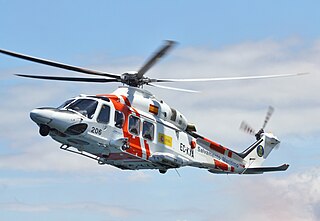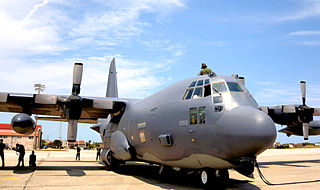
The Sikorsky UH-60 Black Hawk is a four-blade, twin-engine, medium-lift utility military helicopter manufactured by Sikorsky Aircraft. Sikorsky submitted the S-70 design for the United States Army's Utility Tactical Transport Aircraft System (UTTAS) competition in 1972. The Army designated the prototype as the YUH-60A and selected the Black Hawk as the winner of the program in 1976, after a fly-off competition with the Boeing Vertol YUH-61.

The Bell UH-1 Iroquois is a utility military helicopter designed and produced by the American aerospace company Bell Helicopter. It is the first member of the prolific Huey family, as well as the first turbine-powered helicopter in service with the United States military.

Floyd Bennett Field is an airfield in the Marine Park neighborhood of southeast Brooklyn in New York City, along the shore of Jamaica Bay. The airport originally hosted commercial and general aviation traffic before being used as a naval air station. Floyd Bennett Field is currently part of the Gateway National Recreation Area's Jamaica Bay Unit, and is managed by the National Park Service (NPS). While no longer used as an operational commercial, military, or general aviation airfield, a section is still used as a helicopter base by the New York City Police Department (NYPD), and one runway is reserved for hobbyists flying radio-controlled aircraft.

The United States Park Police (USPP) is the oldest uniformed federal law enforcement agency in the United States. It functions as a full-service law enforcement agency with responsibilities and jurisdiction in those National Park Service areas primarily located in the Washington, D.C., San Francisco, and New York City areas and certain other government lands. United States Park Police officers have jurisdictional authority in the surrounding metropolitan areas of the three cities it primarily operates in, meaning they possess both state and federal authority. In addition to performing the normal crime prevention, investigation, and apprehension functions of an urban police force, the Park Police are responsible for policing many of the famous monuments in the United States.

The Bell CH-146 Griffon is a multi-role utility helicopter designed by Bell Helicopter Textron as a variant of the Bell 412EP for the Canadian Armed Forces. It is used in a wide variety of roles, including aerial firepower, reconnaissance, search and rescue and aero-mobility tasks. The CH-146 has a crew of three, can carry up to ten troops and has a cruising speed of 220–260 km/h.

CHC Helicopter is a Texas-based helicopter services company.

The Downtown Manhattan Heliport is a helicopter landing platform at Pier 6, on the East River, in the Financial District of Lower Manhattan in New York City.

The Bell 206 is a family of two-bladed, single- and twin-engined helicopters, manufactured by Bell Helicopter at its Mirabel, Quebec, plant. Originally developed as the Bell YOH-4 for the United States Army's Light Observation Helicopter program, it was not selected by the Army. Bell redesigned the airframe and successfully marketed the aircraft commercially as the five-place Bell 206A JetRanger. The new design was eventually selected by the Army as the OH-58 Kiowa.

Police aviation is the use of aircraft in police operations. Police services commonly use aircraft for traffic control, ground support, search and rescue, high-speed car pursuits, observation, air patrol and control of large-scale public events and/or public order incidents. They may employ rotary-wing aircraft, fixed-wing aircraft, nonrigid-wing aircraft or lighter-than-air aircraft. In some major cities, police rotary-wing aircraft are also used as air transportation for personnel belonging to SWAT-style units. In large, sparsely populated areas, fixed-wing aircraft are sometimes used to transport personnel and equipment.

The Airbus Helicopters H125 is a single-engine light utility helicopter designed and originally manufactured by the French corporation Aérospatiale, and later by Eurocopter. In North America, the H125 is marketed as the AStar. The AS355 Ecureuil 2 is a twin-engine variant, marketed in North America as the TwinStar.

The Bell 412 is a utility helicopter of the Huey family manufactured by Bell Helicopter. It is a development of the Bell 212, with the major difference being the composite four-blade main rotor. It is a twin-turbine helicopter that has been popular on the civilian and military markets, and major users include Canada, Italy, and Japan. Several hundred have been produced since its introduction in 1979, and several iterations of upgrades and variations have been produced, such as with upgraded cockpit electronics.

The Port Authority of New York and New Jersey Police Department, or Port Authority Police Department (PAPD), is a law enforcement agency in New York and New Jersey, the duties of which are to protect and to enforce state and city laws at all the facilities, owned or operated by the Port Authority of New York and New Jersey (PANYNJ), the bi-state agency running airports, seaports, and many bridges and tunnels within the Port of New York and New Jersey. Additionally, the PAPD is responsible for other PANYNJ properties including three bus terminals, the World Trade Center in Lower Manhattan, and the PATH train system. The PAPD is the largest transit-related police force in the United States.

The Lithuanian Air Force or LAF is the military aviation branch of the Lithuanian armed forces. It is formed from professional military servicemen and non-military personnel. Units are located at Zokniai Air Base near the city Šiauliai, at Radviliškis and Kaunas.

The AgustaWestland AW139, now known as the Leonardo AW139, is a 15-seat medium-sized twin-engined helicopter developed and produced by the Italian helicopter manufacturer AgustaWestland, now part of Leonardo. It is marketed at several different roles, including VIP/corporate transport, military use, offshore transport, firefighting, law enforcement, search and rescue, emergency medical service, disaster relief, and maritime patrol.

Air-sea rescue, and aeronautical and maritime search and rescue (AMSAR) by the ICAO and IMO, is the coordinated search and rescue (SAR) of the survivors of emergency water landings as well as people who have survived the loss of their seagoing vessel. ASR can involve a wide variety of resources including seaplanes, helicopters, submarines, rescue boats and ships. Specialized equipment and techniques have been developed. Both military and civilian units can perform air-sea rescue. Its principles are laid out in the International Aeronautical and Maritime Search and Rescue Manual. The International Convention on Maritime Search and Rescue is the legal framework that applies to international air-sea rescue.

The 102nd Rescue Squadron is a unit of the New York Air National Guard 106th Rescue Wing stationed at Francis S. Gabreski Air National Guard Base, Westhampton Beach, New York. The 102nd is equipped with the HC-130J Combat King II transport aircraft.

The Air Support Division (ASD) is the police aviation division of the Los Angeles Police Department (LAPD). It is the largest municipal airborne law enforcement organization in the United States and operates from the LAPD Hooper Heliport.

The New York City Police Department (NYPD) is structured into numerous bureaus and units. As a whole, the NYPD is headed by the Police Commissioner, a civilian administrator appointed by the Mayor, with the senior sworn uniformed officer of the service titled "Chief of Department". The Police Commissioner appoints the First Deputy Commissioner as the department's second-in-command and the Chief of Department as the department's highest ranking uniformed officer. The commissioner also appoints a number of deputy and assistant commissioners who do not have operational command and are solely for support and administrative function. The department is divided into twenty bureaus, six of which are enforcement bureaus. Each enforcement bureau is further subdivided into sections, divisions, and units, and into patrol boroughs, precincts, and detective squads. Each bureau is commanded by a bureau chief. There are also a number of specialized units that are not part of any of the bureaus and report to the Chief of the Department.

Ambulance Victoria (AV), a Victorian agency of the Department of Health, is the statutory provider of pre-hospital emergency care and ambulance services in Victoria. Ambulance Victoria was formed on 1 July 2008 with the merger of the Metropolitan Ambulance Service (MAS), Rural Ambulance Victoria (RAV), and the Alexandra District Ambulance Service (ADAS). Ambulance Victoria has undergone significant reform since 2008.

The Bell 505 Jet Ranger X (JRX) is an American/Canadian light helicopter developed and manufactured by Bell Helicopter. The Bell 505 was unveiled at the 2013 Paris Airshow in June 2013 as the Bell SLS. The Bell 505 designation was officially announced in February 2014. Its first flight occurred on November 11, 2014. The helicopter was certified by Transport Canada in December 2016. By 2023 about 500 have been sold, popular uses so far include for personal, sightseeing, law enforcement, and training.























